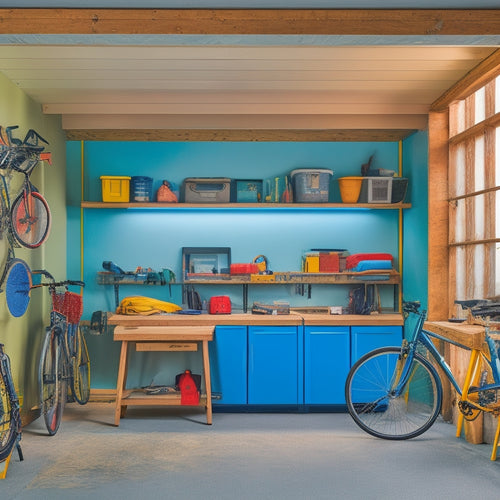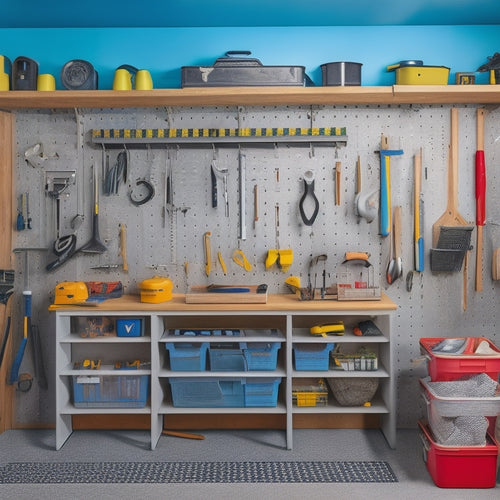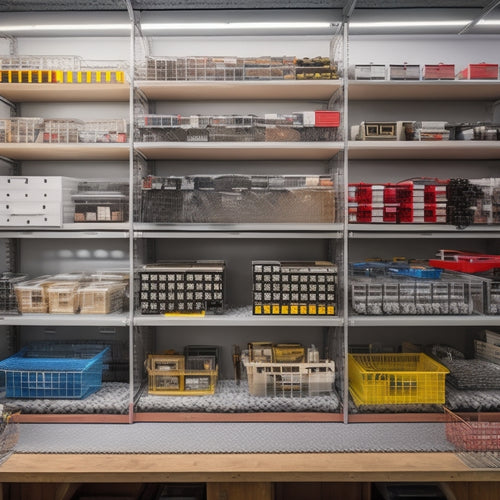
Innovative Ways to Organize Parts Storage
Share
You're allocating a staggering 60% of your warehouse floor space to parts storage, which is likely hindering your facility's overall efficiency. To maximize space, consider implementing vertical storage solutions like wall-mounted systems, stackable shelves, or vertical racks. Mobile shelving and carts can also enhance easy access to parts while minimizing clutter. Additionally, labeling and signage systems, such as color-coded labels and digital signage, can provide quick identification and location of parts. By adopting these innovative strategies, you'll be well on your way to streamlining your parts storage and optimizing your warehouse's operational performance - and there's more to uncover.
Key Takeaways
- Implement vertical storage solutions like wall-mounted systems and multi-tier shelving to optimize space and reduce clutter.
- Utilize mobile shelving and carts with ergonomic workflow layouts to enhance accessibility and reduce fatigue.
- Employ effective labeling and signage systems, including color-coded labels and digital signage, for quick part identification.
- Leverage advanced inventory management software and automated storage and retrieval systems to optimize operations and reduce labor costs.
- Incorporate adjustable and modular storage features, such as adjustable dividers and collapsible containers, to customize storage solutions for specific part sizes.
Maximizing Vertical Storage Space
Sixty percent of warehouses devote a significant amount of floor space to parts storage, which can be a major obstacle to efficient operations. You can overcome this challenge by maximizing your vertical storage space.
Install wall-mounted systems, stackable shelves, or vertical racks to store parts, freeing up floor space for other activities. Consider pegboard solutions with hooks and bins to hang frequently used items, keeping them within easy reach.
Take advantage of overhead compartments and suspended bins to store less frequently used parts, ensuring they're out of the way but still accessible via ladder access.
Multi-tier shelving and modular units can also help you make the most of your ceiling height. By utilizing ceiling storage, you can store bulky or infrequently used items, maintaining a clutter-free floor and promoting a safer working environment.
Customized Bins and Containers
You'll get the most out of your customized bins and containers by implementing effective bin labeling strategies that facilitate easy identification and retrieval of parts.
To optimize container size, you'll want to analyze your parts inventory and design containers that fit each item snugly, reducing wasted space and minimizing clutter.
Bin Labeling Strategies
By implementing a well-thought-out bin labeling strategy, you can greatly reduce the time spent searching for parts and components. This is especially vital in fast-paced industrial settings where efficiency is key. A clear and concise labeling system enables you to quickly identify the contents of each bin, minimizing errors and increasing productivity.
Color coding is an effective way to categorize bins based on material type, size, or function. Digital labels with barcode systems can be easily updated and provide an additional layer of accuracy. Magnetic labels offer flexibility and can be reused multiple times. Visual cues such as icons or images can also be used to differentiate between bins, making it easier to locate specific parts.
When designing your labeling strategy, consider the user interface and guarantee it's user-friendly and intuitive. Choose durable materials that can withstand the rigors of your work environment.
Avoid using seasonal themes or other non-descriptive labels that may cause confusion. Instead, focus on material categorization and size differentiation to create a logical and organized system. By doing so, you'll be able to quickly locate the parts you need, reducing downtime and increasing overall efficiency.
Container Size Optimization
In fast-paced industrial settings, where every minute counts, refining container size is crucial to maximizing storage capacity and streamlining workflows. You can't afford to waste space or time searching for parts. Customized bins and containers help you achieve peak storage density by tailoring the container size to the specific part or component being stored. This guarantees that you're not sacrificing precious floor space to oversized containers.
When designing your customized bins and containers, consider the following factors to guarantee peak container size refinement:
- Measure the parts to be stored to determine the ideal container size
- Consider the weight and fragility of the parts when selecting container materials
- Choose containers with durable construction to withstand frequent handling
- Design containers with easy-open lids or compartments to reduce retrieval time
- Label containers clearly with part numbers, descriptions, and quantities to facilitate quick identification
Labeling and Signage Systems
Three key components of an effective parts storage system are identification, location, and accessibility. You achieve these by implementing a well-designed labeling and signage system. This system should incorporate color-coded labels, standardized icons, and clear labeling to guarantee quick and easy identification of parts.
Digital signage and QR code labeling can also be used to provide additional information, such as part numbers, descriptions, and storage locations.
Visual management is essential in a parts storage system, and intuitive signage helps you maneuver the storage area efficiently. Modular signage allows you to easily update or reconfigure your signs as your inventory changes.
Flexible labeling enables you to make changes to label information in real-time, ensuring that your system remains accurate and up-to-date.
Safety signage is also vital, as it alerts personnel to potential hazards and provides critical information in emergency situations.
Inventory Management Software
Your parts storage system's backbone is its inventory management software, which streamlines your operations and optimizes storage capacity. This software is the central nervous system that keeps your parts storage system running smoothly, efficiently, and safely.
With cloud-based solutions, you can access your inventory data from anywhere, at any time. You'll have real-time tracking capabilities, analytics dashboards, and user-friendly interfaces that make it easy to manage your inventory.
-
You'll be able to track parts as they move in and out of storage, reducing lost or misplaced items.
-
Mobile accessibility guarantees that you can scan barcodes and update inventory levels from the warehouse floor.
-
Integration capabilities allow you to connect with suppliers, enabling seamless communication and cost control.
-
Inventory forecasting capabilities help you anticipate demand and avoid stockouts or overstocking.
-
Supplier management features let you track lead times, pricing, and quality, guaranteeing you get the best deals.
Mobile Shelving and Carts
You'll find that mobile shelving and carts offer a range of benefits for parts storage, starting with easy access design that allows you to quickly locate and retrieve components.
By selecting space-saving configurations, you can maximize your facility's square footage while minimizing clutter and disorganization.
Furthermore, an ergonomic workflow layout can be achieved by positioning mobile shelving and carts to reduce bending, stretching, and other movements that can lead to fatigue and injury.
Easy Access Design
As inventory management becomes increasingly complex, easy access to parts storage has become a critical factor in maximizing efficiency and productivity.
You need to be able to quickly locate and retrieve parts to minimize downtime and keep your operations running smoothly.
To achieve this, consider incorporating easy access design elements into your parts storage system, such as:
- Magnetic storage for small metal parts, keeping them organized and easily accessible
- Pull out trays and drawer organization systems that allow you to see everything at a glance
- Clear containers and modular shelving that provide a clear view of contents and make it easy to restock
- Tool storage systems with pegboard systems and stackable bins that keep frequently used items within reach
- Sliding cabinets and overhead racks that maximize vertical storage space while keeping items easily accessible
Space-Saving Configurations
Optimizing storage capacity without sacrificing accessibility is a delicate balance in parts storage. You need to maximize your available space while ensuring that parts are easily accessible to improve efficiency and reduce downtime.
One effective way to achieve this balance is by implementing space-saving configurations such as mobile shelving and carts. These solutions allow you to make the most of your storage area while keeping frequently used parts within easy reach.
| Space-Saving Solution | Description | Benefits |
|---|---|---|
| Modular Shelving | Adjustable shelves that can be customized to fit specific part sizes | Maximizes vertical storage space, easy to reconfigure |
| Multi Tiered Racks | Stacked storage levels for bulk items | Increases storage capacity, reduces floor space |
| Collapsible Containers | Foldable containers for storing small parts | Saves space when not in use, easy to transport |
Additionally, consider using overhead storage, corner shelving, and sliding drawers to further optimize your storage space. You can also employ pegboard systems to hang frequently used tools and accessories, keeping them organized and within reach. By implementing these space-saving configurations, you can create a more efficient and organized parts storage system.
Ergonomic Workflow Layout
By designing an ergonomic workflow layout, you can streamline your parts storage operation and enhance productivity. This involves strategically placing mobile shelving and carts to minimize walking distances, reduce lifting, and optimize workflow efficiency.
-
Mobile shelving units positioned near workstations to reduce travel time and increase access to frequently used parts.
-
Carts with ergonomic tool placement, keeping essential tools within easy reach to prevent strain and fatigue.
-
Workstations organized to minimize bending, stretching, and twisting, reducing the risk of injury.
-
Aisles wide enough for easy passage, ensuring safe movement and reducing congestion.
-
Shelving and carts labeled and color-coded to facilitate quick identification and retrieval of parts.
Shelving With Adjustable Dividers
When managing a vast inventory of parts, you need a shelving system that can adapt to changing storage requirements. Adjustable dividers are a vital component of this system, allowing you to reconfigure your storage space as needed.
Look for dividers made from durable materials, such as heavy-duty plastic or metal, that can withstand the weight of your parts.
Adjustable heights enable you to customize your shelving to fit parts of varying sizes, guaranteeing maximum storage capacity. Modular systems allow you to add or remove dividers as needed, making it easy to reconfigure your storage space. This enhances accessibility, as you can create separate compartments for frequently used parts and reduce clutter.
When selecting a shelving system, consider tool integration, such as built-in bins for small parts or hooks for hanging tools. Custom configurations can be designed to meet your specific needs.
Durability testing and user feedback are essential in confirming the system meets your requirements. Follow installation tips and maintenance strategies to verify the system remains functional and safe over time.
Automated Storage and Retrieval
Five key benefits make automated storage and retrieval systems an attractive solution for parts storage: increased efficiency, reduced labor costs, minimized errors, enhanced inventory control, and maximized floor space.
By integrating automated systems into your parts storage, you'll experience a significant reduction in labor costs and errors, while also gaining greater control over your inventory.
-
Imagine rows of smart shelving units that can store and retrieve parts with precision and speed, maximizing your floor space and reducing the risk of inventory damage.
-
Envision a user-friendly interface that allows you to easily track and manage your parts inventory, providing real-time data and predictive analytics to inform your business decisions.
-
Visualize robotic solutions working around the clock to retrieve and store parts, streamlining your workflow automation and ensuring that your operations run smoothly and efficiently.
-
Think about the benefits of technology integration, which enables seamless communication between your automated storage system and other business systems, ensuring accuracy and reliability.
-
Consider the peace of mind that comes with knowing your parts are stored safely and securely, with automated systems that minimize the risk of damage or loss.
Compact Storage for Small Parts
In compact spaces, where every inch counts, optimizing storage for small parts is essential to maintaining a streamlined operation. You can't afford to waste precious space on inefficient storage solutions. That's why compact storage solutions are a must-have.
Stackable organizers are a great option for small parts storage. They provide maximum storage capacity while minimizing floor space. These organizers come in various sizes and configurations, allowing you to customize your storage system to fit your specific needs. By stacking them, you can store more parts in a smaller area, keeping your workspace clutter-free and organized.
Magnetic storage is another innovative solution for small parts. Magnetic bins and strips can be attached to walls, benches, or even machines, providing easy access to frequently used parts. This type of storage is ideal for small metal parts, such as screws, nuts, and bolts.
Ergonomic Workstation Design
A well-designed workstation is the backbone of an efficient operation, and ergonomic workstation design plays a critical role in this equation.
As you design your workstation, you'll want to prioritize comfort, flexibility, and efficiency. This means incorporating ergonomic tools and features that support your posture, reduce strain, and optimize your workflow.
- Adjustable furniture that accommodates different workstation heights and postures
- Task-specific setups that minimize reaching and bending
- Comfort features like built-in wrist rests and anti-fatigue mats
- Collaborative spaces that facilitate communication and teamwork
- User-centered design that prioritizes your needs and preferences
Frequently Asked Questions
How Can I Ensure Employee Compliance With New Storage Procedures?
You'll guarantee employee compliance with new procedures by conducting regular training sessions, providing clear instructions, and establishing effective feedback mechanisms, allowing workers to report concerns and receive timely guidance, thereby promoting a safe and efficient work environment.
What Is the Ideal Storage Temperature for Sensitive Electronic Components?
Are you aware that just a few degrees can compromise electronic components? You'll want to maintain a stable storage temperature between 60°F to 75°F (15°C to 24°C) with temperature monitoring and environmental controls to guarantee their reliability and longevity.
Can I Use Existing Shelving Units With New Storage Solutions?
You can repurpose existing shelving units by incorporating shelving enhancements, such as bins, dividers, and labels, and adding storage accessories, like baskets and hooks, to optimize space and guarantee safe, organized storage for sensitive electronic components.
How Do I Handle Storage for Oversized or Irregularly Shaped Parts?
Imagine a puzzle piece that doesn't fit; oversized or irregularly shaped parts can be a storage nightmare. You'll need to think vertically, utilizing custom shelving solutions that accommodate unique dimensions, ensuring safe and efficient storage without compromising precious floor space.
Are There Any OSHA Regulations I Need to Consider for Parts Storage?
You'll need to familiarize yourself with OSHA's safety standards for material handling, ensuring your parts storage complies with regulations on ergonomic design, clearance, and accessibility to prevent injuries and accidents.
Conclusion
You've finally perfected the art of organizing parts storage, only to realize that the real challenge lies in maintaining it. With so many innovative solutions at your fingertips, it's ironic that clutter and disorganization can still creep back in. But don't let it - utilize the power of vertical storage, customized bins, and state-of-the-art software to stay on top of your inventory. Your sanity (and your parts) will thank you.
Related Posts
-

7 Essential Foldable Workbenches for Garages
When selecting a foldable workbench for your garage, you'll want to contemplate factors such as space-saving design, ...
-

Advantages of a Pegboard System in Your Garage
You can instantly alter your garage into a more organized, efficient, and productive space by installing a pegboard s...
-

10 Essential Steps for Small Parts Bin Storage
To optimize your small parts bin storage, start by defining your storage needs and goals, considering factors like av...


